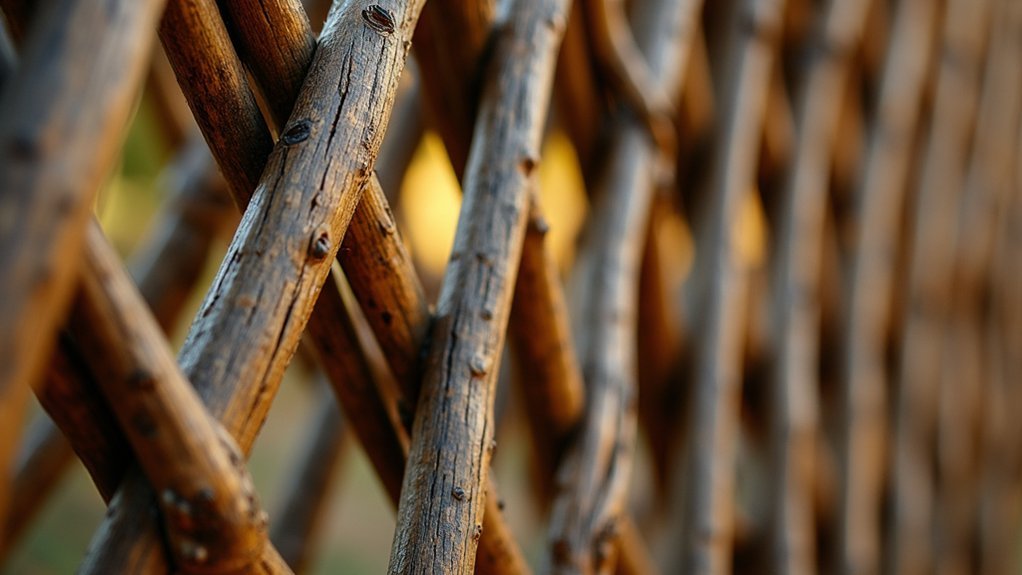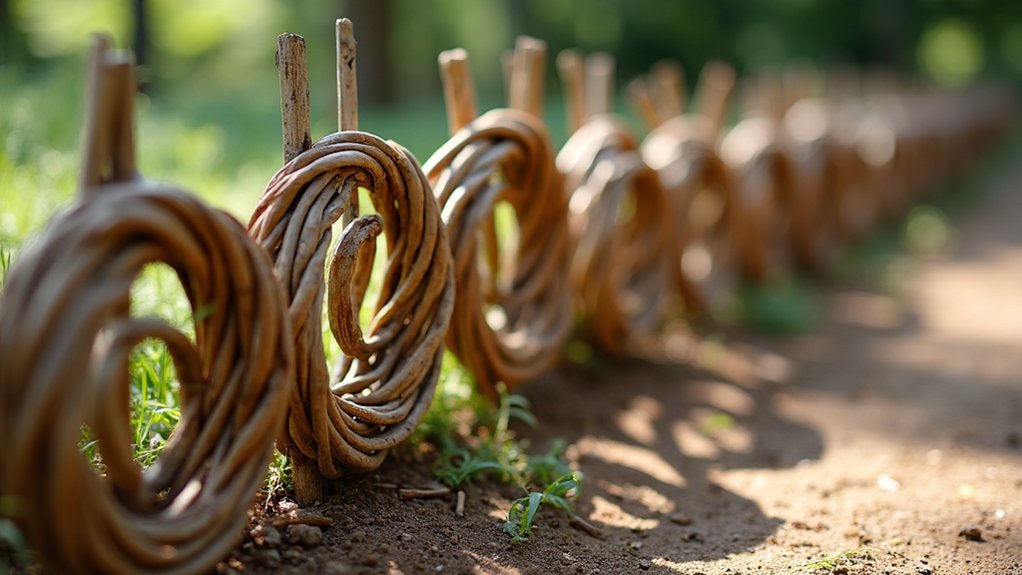Three rustic willow weaving patterns transform your garden fencing: Traditional Diamond Lattice creates timeless crisscrossed designs for visual interest and stability; Horizontal Herringbone delivers striking V-shaped weaves that distribute tension evenly; and Spiral Twist Border wraps flexible rods around vertical supports for elegant contours. You’ll appreciate how each pattern offers customizable spacing while introducing natural texture and artisanal charm to your outdoor space. Discover how these sustainable boundaries can elevate your landscape with minimal maintenance.
Traditional Diamond Lattice Willow Weave

While many fence designs come and go with passing trends, the Traditional Diamond Lattice Willow Weave remains a timeless choice for rustic garden boundaries.
You’ll find this technique creates distinctive diamond patterns by crisscrossing green willow branches, delivering both visual appeal and structural stability to your willow fence.
This eco-friendly option allows you to customize spacing to suit your garden’s style and contours.
The flexible nature of willow makes it ideal for adapting to various landscapes while maintaining its charming aesthetic.
Willow’s remarkable flexibility embraces landscape contours while preserving its rustic charm and organic appeal.
Since willow grows quickly, you’re choosing a sustainable fencing solution that harmonizes with natural surroundings.
Remember to incorporate regular pruning into your maintenance routine to preserve the diamond lattice structure and guarantee your fence’s longevity and continued beauty.
Horizontal Herringbone Willow Pattern
Gardeners seeking distinctive visual appeal often gravitate toward the Horizontal Herringbone Willow Pattern for its striking V-shaped weave. This technique adds both rustic charm and structural integrity to your garden fence as the zigzag design distributes tension evenly across the structure.
You’ll achieve the best results using fresh green willow rods, which are more pliable and easier to manipulate into the characteristic V-pattern. Weave the rods alternately in opposite directions to create the dynamic herringbone effect.
| Feature | Benefit | Maintenance |
|---|---|---|
| V-shaped weave | Visual dynamism | Regular pruning |
| Interlocking design | Enhanced stability | Check for loose rods |
| Zigzag pattern | Even tension distribution | Preserve with seasonal care |
Don’t forget regular maintenance to preserve your horizontal herringbone fence’s beauty and structural integrity over time.
Spiral Twist Border Technique

For those who enjoy the intricate V-pattern of herringbone weaving but desire something even more eye-catching, the Spiral Twist Border Technique offers an elegant alternative. This method creates visually striking fences while providing superior structural integrity that prevents sagging over time.
To execute this technique, you’ll want to use flexible green willow branches, which are easier to manipulate during the weaving process. Begin by securing a willow rod at the base, then twist it around vertical uprights as you work upward, maintaining consistent tension throughout.
Supple green willows twist gracefully between uprights, each rod secured firmly at the base before spiraling upward with steady tension.
What makes the spiral twist border technique particularly appealing is its versatility. You can adjust the spacing and thickness of the willow rods to create customizable fence designs that complement any garden aesthetic.
The evenly distributed tension guarantees your beautiful border will maintain its shape for years to come.
Frequently Asked Questions
What Type of Willow Is Best for a Living Fence?
For living fences, you’ll find Brown willow (Salix viminalis) is your best choice due to its flexibility and strength. Osier TORTUOSA and Flanders red willow are excellent alternatives that add visual interest.
How Long Will Willow Fencing Last?
Your willow fencing will typically last 5-10 years. You’ll get maximum longevity by properly installing it, choosing green willow, and performing regular maintenance. Environmental conditions like moisture and wind exposure also affect durability.
What Is the Best Wood for Weaving a Fence?
For weaving a fence, you’ll find brown willow (Salix viminalis) is your best choice. It’s incredibly flexible when freshly cut. For sturdy uprights, you can’t beat sweet chestnut with its excellent durability.
Is Willow Wood Good for Fencing?
Yes, willow wood is excellent for fencing. You’ll find it’s naturally flexible, strong, and perfect for weaving techniques. It’s also eco-friendly and sustainable, lasting 5-10 years when you use freshly cut green willow.
In Summary
You’ve now mastered three versatile willow weaving patterns that’ll transform your garden boundaries. Whether you’ve chosen the elegant Diamond Lattice, the sturdy Herringbone, or the decorative Spiral Twist, you’re carrying on an ancient craft while creating sustainable, biodegradable fencing. Don’t be afraid to experiment with variations or combine techniques as your confidence grows. Your handcrafted willow fence isn’t just functional—it’s a living artwork that connects you to traditional craftsmanship.





Leave a Reply